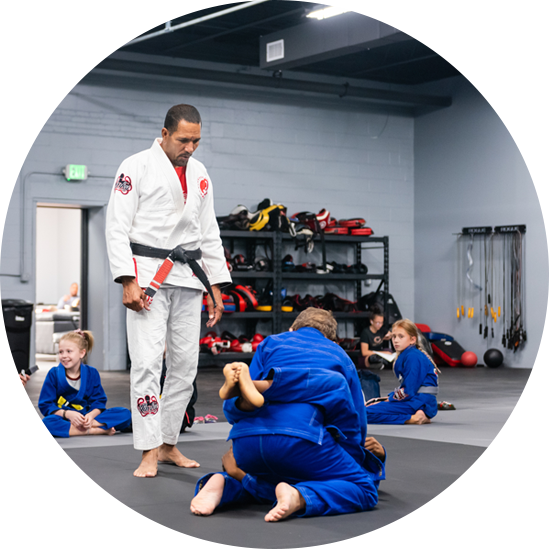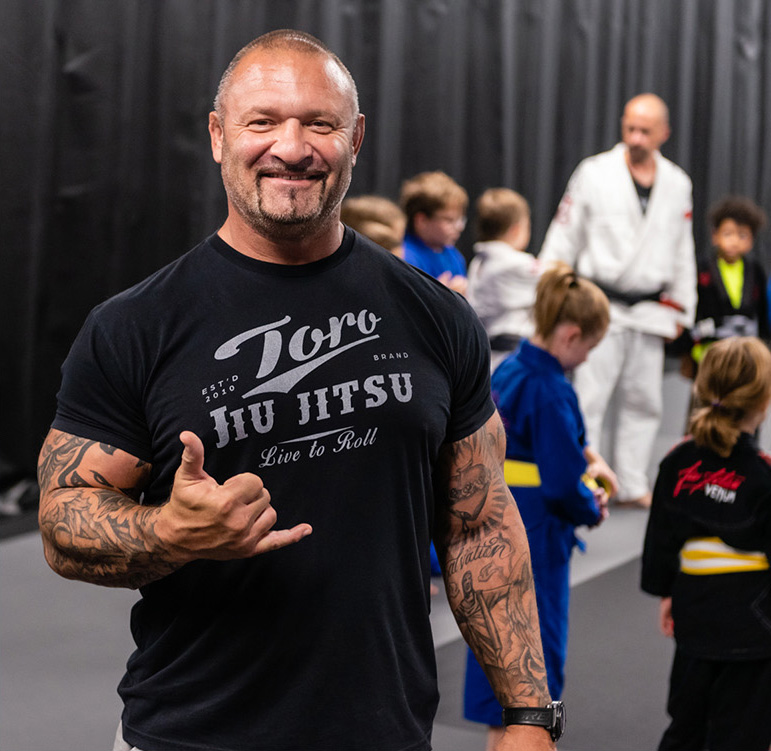Brazilian Jiu-Jitsu Classes
John Rallo (a Renzo Gracie black belt) teaches top-level Jiu-Jitsu that he learned from Renzo himself. All the instructors are credible and are teaching cutting edge Jiu-Jitsu techniques.
BJJ classes are ideal for someone looking to compete as a martial artist, get toned and lose weight, learn basic self defense, test mental toughness, or challenge themselves physically and mentally.
Brazilian Jiu-Jitsu can provide you with far more extensive results than typical aerobic exercise. The resistance encountered while rolling provides you with a good base to improve your core strength through intense abdominal workout, increase your muscle tone, and reduce your body fat while improving your balance, bodily coordination, cardiovascular capacity, and muscular endurance.
At Ground Control Baltimore, safety is paramount. Accidents may happen, however, lack of seriousness during training and the resultant careless application of technique or counters contribute greatly to injury. Careless practice is disrespectful to the spirit of Gracie Jiu-Jitsu.
Practically anyone can utilize the techniques created by Carlos Gracie. Carlos Gracie, when he created his revolutionary system, weighed no more than 135 lbs. The core principle of Gracie Jiu-jitsu is to provide a method for smaller, weaker individuals to protect themselves from bigger, stronger attackers.
To learn more about Brazilian Jiu-Jitsu classes, contact us here.

BJJ History
Mitsuyo Maeda Jiu-Jitsu began with Mitsuyo Maeda, a Japanese Jiu-Jitsu master and member of the Kodokan. Maeda emigrated to Brazil in the 1910s where an influential businessman named Gastão Gracie helped him get established. In return for his aid, Maeda taught the fighting art to Gastão’s son Carlos Gracie, who then taught the art to his brothers and sons. When Maeda taught the art to the Gracies he called it Jiu-jitsu. The Gracie family refined this art form into what is now known as Gracie Jiu-Jitsu.
BJJ first hit the mainstream when Royce Gracie won the first ever Ultimate Fighting Championships. After that, the Gracie family revolutionized martial arts by spreading one of the most effective fighting techniques across the world.
Brazilian Jiu-Jitsu differs from other martial arts in that it provides solutions for all possible stages of combat. Other disciplines like Tae Kwon Do or Karate focus on striking and rely on a person’s strength and speed to deliver damage, but speed and strength doesn’t matter when you’re on your back. Brazilian Jiu-Jitsu differs from other martial arts fundamentally. While other martial arts rely heavily on strength and speed, Brazilian Jiu-Jitsu relies on superior technique and leverage.
A Gi (sometimes referred to as Kimono) is the uniform that is typically worn when training Jiu-Jitsu. It consists of 3 pieces: a jacket (or top), pants, and a belt. The material in which the three pieces are made is specially reinforced to withstand the rigors of daily practice. Many Jiu-Jitsu players regard their Gi in the same way a knight would their armor. Most practitioners of Jiu-Jitsu who advocate the usage of the Gi cite the more technical aspect of grappling with a Gi.
As with other martial arts, the progress of a student is marked with a series of colored belts. Unlike other martial arts where Black Belt marks a person’s proficiency in a style, in Gracie Jiu-Jitsu the rank of Black Belt is conferred to individuals who have mastered the art of Brazilian Jiu-Jitsu.
The belts in order are: White, Blue, Purple, Brown and Black. Often schools award four stripes for White through Brown belts. Black Belts are typically awarded one stripe every three years up to ten stripes. There are special classifications for Black Belts fighter and instructors. Instructors have Black Belts with Red bands and Black Belt fighters have White Bands. Typically, Black Belt instructors are not allowed to promote others up to Black Belt rank until they receive their first stripe. The ranks for children are different. Blue belt and higher ranks have age requirements so children have the following ranks beginning with White, Yellow, Orange and Green. Each belt has 4 stripes. These belts are utilized until age 16. Typically, it takes anywhere from 8 to 15 years to attain the rank of Black Belt in Jiu-Jitsu. Each belt (with the exception of Blue) takes about 2-5 years of dedicated practice; Blue Belt can often be attained in about a year of dedicated study.

Have A Question?
Ground Control – Baltimore Academy
8303 Pulaski Hwy, Suite B, Rosedale, MD 21237 | (410) 340-5925



